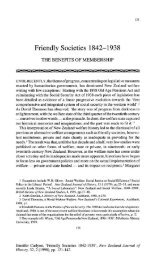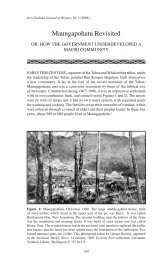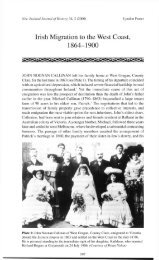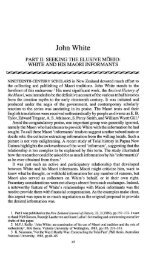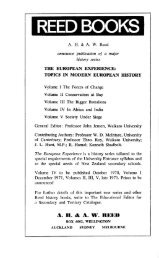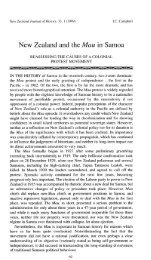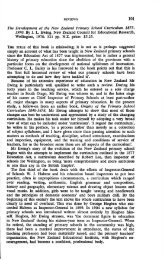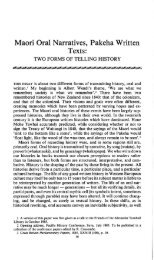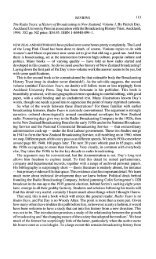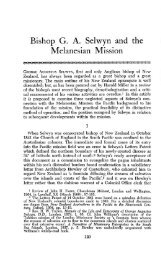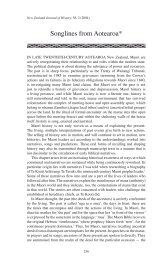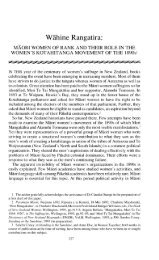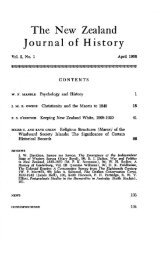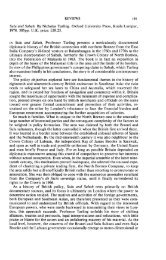Road to Exile. The Indonesian Nationalist Movement 1927-1934. By ...
Road to Exile. The Indonesian Nationalist Movement 1927-1934. By ...
Road to Exile. The Indonesian Nationalist Movement 1927-1934. By ...
You also want an ePaper? Increase the reach of your titles
YUMPU automatically turns print PDFs into web optimized ePapers that Google loves.
92 REVIEWS<br />
<strong>Road</strong> <strong>to</strong> <strong>Exile</strong>. <strong>The</strong> <strong>Indonesian</strong> <strong>Nationalist</strong> <strong>Movement</strong> <strong>1927</strong>-<strong>1934.</strong> <strong>By</strong> John<br />
Ingleson. Published for the Asian Studies Association of Australia by Heinemann<br />
Educational Books (Asia) Ltd., Singapore, 1979. 254pp.<br />
PRIMARILY this book must be seen as a contribution <strong>to</strong> the his<strong>to</strong>ry of interwar<br />
<strong>Indonesian</strong> nationalism, and in particular <strong>to</strong> the his<strong>to</strong>ry of the 'secular' nationalists<br />
who were in the event <strong>to</strong> emerge as leaders of independent Indonesia<br />
postwar. It traverses some ground made familiar by John Legge, Bernhard Dahm<br />
and others, as well as by Dr Ingleson's own Perhimpunan Indonesia and the<br />
<strong>Indonesian</strong> <strong>Nationalist</strong> <strong>Movement</strong> 1923-1928 (1975). Beginning with a short<br />
account of PI, it moves <strong>to</strong> a discussion of the study clubs in which <strong>Indonesian</strong>s<br />
returning from the Netherlands played so important a role. It considers the formation<br />
of the Partai Nasional Indonesia in the wake of the suppression of the Communist<br />
revolts of 1926-7 and the unsuccessful attempt <strong>to</strong> create in the Permufakatan<br />
Perhimpunan-perhimpunan Politik Kebangsaan Indonesia a federation<br />
of political parties, including both 'secular' and Islamic. It deals also—and<br />
rather sensitively—with the actions of the colonial government: with De Graeff's<br />
liberalism, and his somewhat wistful hopes of winning over cooperating nationalists<br />
<strong>to</strong> the regime, and by contrast, with his successor De Jonge's conservatism,<br />
intensified with the onset of the depression by recollection on the part of Dutch<br />
residents and officials of the insurrections a few years before. If some of this<br />
ground is familiar, Dr Ingleson gives us new information and new insights, making<br />
use of official Dutch archives and private papers and of contemporary Dutch<br />
and <strong>Indonesian</strong> newspapers and journals. He presents, finally, a small but<br />
penetrating portrait of Sukarno, both the ora<strong>to</strong>r in full spate, and the prisoner<br />
who so much lost his confidence in confinement that he offered <strong>to</strong> refrain from<br />
all further political activity in return for his release.<br />
Those who do not specialize in <strong>Indonesian</strong>, or even Southeast Asian studies,<br />
will still find this book interesting. For the terms in which it discusses <strong>Indonesian</strong><br />
nationalism are of wider relevance. <strong>The</strong> nationalists of the 1920s believed that<br />
their only chance of upsetting the power of the colonial rulers was through<br />
developing the apparent counter-power of the masses. As Dr Ingleson points out,<br />
they shared this view with the Indian nationalists. It was a recipe for other Asian<br />
nationalist movements, <strong>to</strong>o: Rizal and his Liga, Aung San and his Anti-Fascist<br />
People's Freedom League, would have recognized the concept of a countervailing<br />
force, of a state within a state. Maybe the fundamental weakness of the policy<br />
was also shared. How did you judge when <strong>to</strong> pit this power against the government?<br />
How did you act if the government simply failed <strong>to</strong> recognise its challenge?<br />
<strong>The</strong> Dutch government could insulate the peasantry from the movement in Indonesia;<br />
they could undermine mass action by arresting the leaders. Rizal, <strong>to</strong>o, had<br />
been arrested: the Spaniards were displaced by the Americans. Aung San won<br />
perhaps less because of his own strength than because of the weakness of the<br />
British, and their unwillingness or inability <strong>to</strong> rely on the postwar Indian army.<br />
And if the 'secular' nationalists of Dr Ingleson's period gave currency <strong>to</strong> the concept<br />
of an <strong>Indonesian</strong> nation, their realising it surely depended on the incursion of<br />
the Japanese and the disruption of colonial power that was brought about by<br />
external forces. <strong>The</strong> nationalist movement in Indonesia, like that in other colonial<br />
countries, enjoyed a success like nineteenth-century Italy's: though it struggled,<br />
its success was out of all proportion <strong>to</strong> its intrinsic strength. It still had <strong>to</strong> face the
REVIEWS 93<br />
task of turning a 'geographical expression' in<strong>to</strong> a nation.<br />
That said, it can also be argued that, in the longer term at least, there was an<br />
inconsistency between democratic advance back in Europe and authoritarianism<br />
overseas. It was not only that the Netherlands bred students like those who joined<br />
PI. It also nurtured attitudes like De Graeff's: a policy like De Jonge's could not<br />
forever be accepted in the Netherlands. But a policy like De Graeff's had little<br />
chance in the Indies. Even apart from the impact of the depression or the war, it<br />
seems doubtful whether any lasting compromise could have been reached<br />
between <strong>Indonesian</strong> nationalism and Dutch authority. Empire is hard <strong>to</strong> relinquish.<br />
Though colonial rulers have been prepared <strong>to</strong> go, they have often<br />
wished—as, again, in Burma—<strong>to</strong> leave behind a monument <strong>to</strong> their good intentions,<br />
one which they had designed.<br />
If Dr Ingleson's book interests both by interpreting a phase of <strong>Indonesian</strong><br />
nationalism and by provoking comparison with other nationalisms, it is noticed<br />
in these pages for another reason also. His<strong>to</strong>rians have been anxious that<br />
specialised research of the best kind should continue <strong>to</strong> be published, despite the<br />
contracted prospects of the profession and the mounting cost of books. <strong>The</strong>y<br />
have initiated self-help, in the United Kingdom, for example, through the Royal<br />
His<strong>to</strong>rical Society series, Studies in His<strong>to</strong>ry. With colleagues in other disciplines,<br />
they have also initiated a Southeast Asia Publications Series on the part of the<br />
Asian Studies Association of Australia, of which Dr Ingleson's book is the first.<br />
Maybe New Zealanders do not have the resources <strong>to</strong> follow these examples. But<br />
they should salute the courage and enterprise of their trans-Tasman colleagues,<br />
and welcome their generosity: members of the New Zealand Asian Studies Society<br />
are offered the same concession price as ASAA members (AS6.35 paper, ASH.55<br />
cased).<br />
NICHOLAS TARLING<br />
University of<br />
Auckland<br />
Colonial Cap and Gown. <strong>By</strong> W.J. Gardner, published by Whitcoulls for the<br />
University of Canterbury, 1979. 142pp. N.Z. price: $6.95.<br />
FORTUNATE enough <strong>to</strong> house its own his<strong>to</strong>rians, the college and university is one<br />
of the few institutions in New Zealand life which has been relatively well served<br />
by the professionals. But W.J. Gardner in Colonial Cap and Gown is the first <strong>to</strong><br />
go beyond the standard narrative of a particular alma mater and try <strong>to</strong> offer some<br />
broader generalizations about the university in a new society. Gardner does not<br />
deal with all the New Zealand colleges, but simply the first two, Canterbury and<br />
Otago, which he treats alongside the three earliest Australian universities,<br />
Sydney, Melbourne and Adelaide. All five were founded between 1850 and 1874.<br />
In design this is an exciting project. <strong>The</strong> comparative perspective, the attempt <strong>to</strong><br />
integrate New Zealand mid-Vic<strong>to</strong>rian his<strong>to</strong>ry in<strong>to</strong> that of Australian his<strong>to</strong>ry, and<br />
the author's eagerness <strong>to</strong> hunt for larger generalizations, raise high expectations.<br />
Some of this promise is indeed fulfilled. This book is most readable, written



